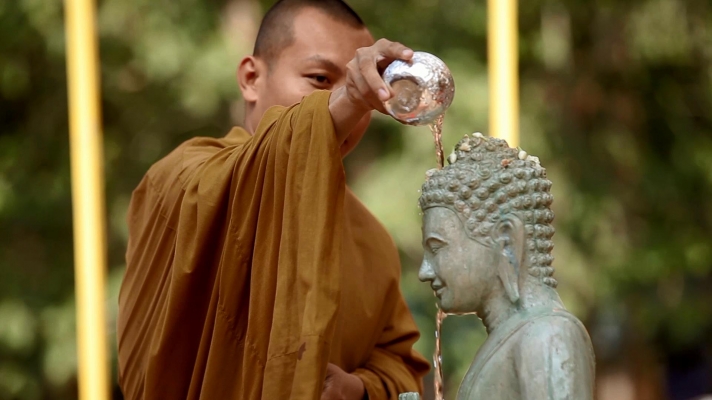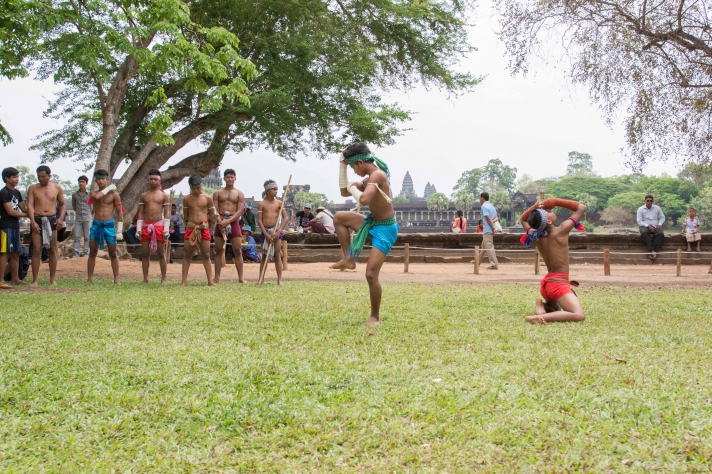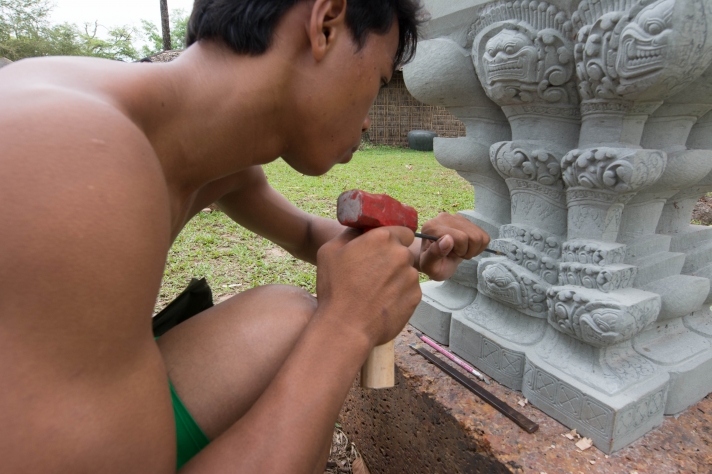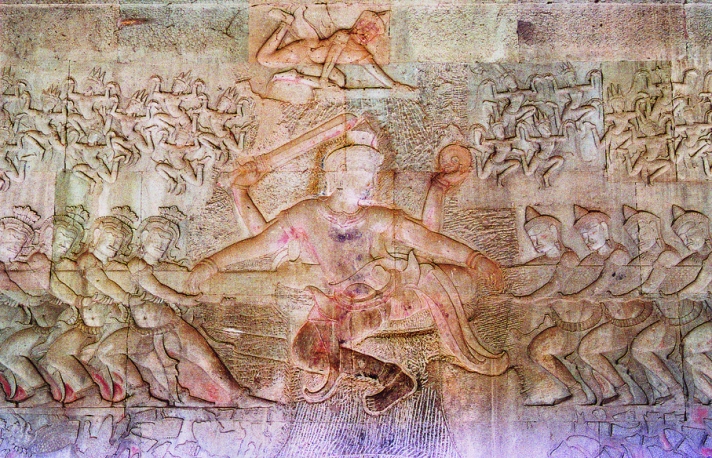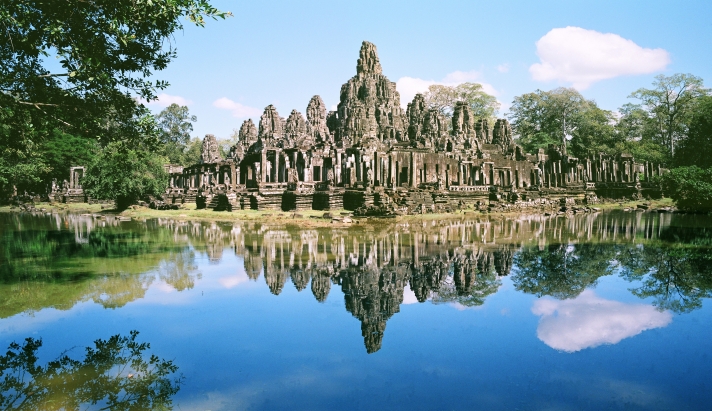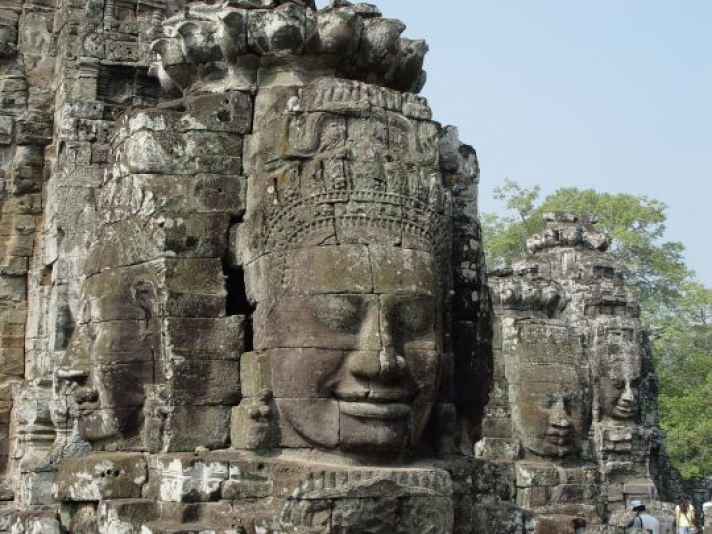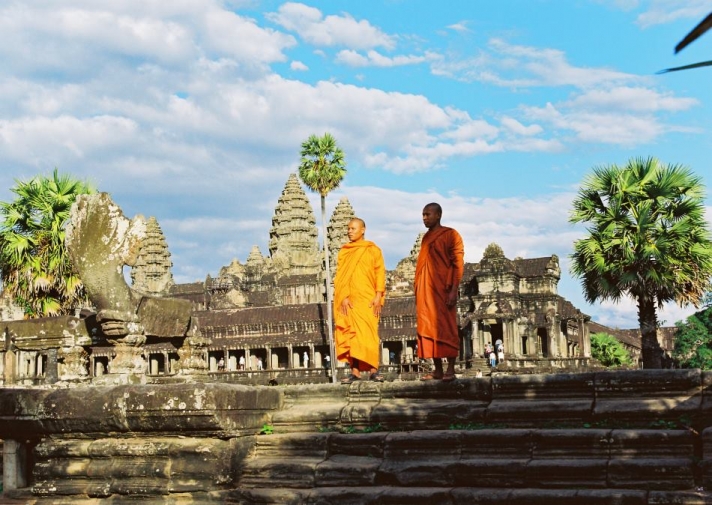Cambodia Review
Cambodia is well-known country in Southeast Asia, steeped in history and rich culture. But three decades of war destroyed nearly the entire society, included economic infrastructure and human resources that are the key factor in developing a country, in particular, its tourism industry.
Cambodia, a country in Southeast Asia in the southern part of Indochina, covers an area of 181,035 square kilometers and has a population of 14.2 millions people in 2013 est. The country ‘s shape is an almost-square polygon,with Kampong Thom province from north to south and 560 kilometers from west to east. This shape makes Cambodia east for tourists to navigate and poses no difficulties for the development of tourism.
People have been living within the area covered by the present-day country of Cambodia at least since the 5th millennium BC The ancient Kingdom of Funan occupied a wider area, and it was during that period that the culture became heavily influenced by Hinduism. The state of Chenla then arose. The Khmer Empire had its golden age in the 9th to the 13th centuries, when huge temple complexes were built, most notably Angkor Wat.
Spanish and Portuguese missionaries visited from the 16th century, and Cambodia became a protectorate of France in the 19th century, being ruled as part of French Indochina. Cambodia became an independent kingdom in 1953 under Norodom Sihanouk. The Vietnam War extended into Cambodia, giving rise to the Khmer Rouge, which took Phnom Penh in 1975 and carried out a campaign of mass killing. Following an invasion by Vietnam, the Khmer Rouge were deposed and the People's Republic of Kampuchea was established. After years of isolation, the war-ravaged nation was reunited under the monarchy in 1993 and has seen rapid economic progress while rebuilding from decades of civil war.
The Khmer people were among the first inhabitants of South East Asia. They were also among the first in South East Asia to adopt religious ideas and political institutions from India and to establish centralized kingdoms comprising large territories. The earliest known kingdom in the area, Funan, flourished from around the 1st to the 6th century. This was succeeded by Chenla, which controlled large parts of modern Cambodia, Vietnam, Laos, and Thailand.
1*Funan Kingdom (1st century AD – 550)
The Funanese Empire rose to eminence from its affluent and powerful home city of Óc Eo (in present-day Vietnam), known in the Roman Empire as Kattigara, meaning the Renowned City. Contacts with the distant Roman Empire are evidenced by the fact that Roman coins have been found at archeological sites dating from the 2nd and 3rd centurie However, most of the foreign trade of the Funan Empire was carried on much closer to home with India, especially the Bengal area of India. Trade with India commenced well before 500 BC (before the widespread use of Sanskrit as a language in India) Trade with China began after the southward expansion of the Han Dynasty around the 2nd century BC. Remnants of Chinese influence can be seen in axes excavated in Cambodia, which display Han-style elements With the Indian trade came the Indianization of the culture of Funan and the religion of Hinduism. Hinduism produced a syncretism phenomenon with other previous religions and beliefs already present in the Khmer culture. Funan and its succeeding societies which occupied this section of Southeast Asia would remain mainly Hindu in religion for about 900 years. Some cultural features and customs of Hinduism continue to exist within the current society.
The empire reached its greatest extent under the rule of Fan Shih-man in the early 3rd century, extending as far south as Malaysia and as far west as Burma. The Funanese established a strong system of mercantilism and commercial monopolies that would become a pattern for empires in the region. Exports from the Funan Empire were largely forest products and precious metals—including accessories such as gold elephants, ivory, rhinoceros horn, kingfisher feathers, wild spices like cardamom, lacquer hides and aromatic wood. Fan Shih-man expanded the fleet and improved the Funanese bureaucracy, creating a quasi-feudal pattern that left local customs and identities largely intact, particularly in the empire's farther reaches.
2*Chenla Kingdom (6th century – 802)
The Khmers, vassals of Funan, reached the Mekong river from the northern Menam River via the Mun River Valley. Chenla, their first independent state developed out of Funanese influence.
Ancient Chinese records mention two kings, Shrutavarman and Shreshthavarman who ruled at the capital Shreshthapura located in modern day southern Laos. The immense influence on the identity of Cambodia to come was wrought by the Khmer Kingdom of Bhavapura, in the modern day Cambodian city of Kampong Thom. Its legacy was its most important sovereign, Ishanavarman who completely conquered the kingdom of Funan during 612-628. He chose his new capital at the Sambor Prei Kuk, naming it Ishanapura.
After the death of Jayavarman I in 681, turmoil came upon the kingdom and at the start of the 8th century, the kingdom broke up into many principalities. Pushkaraksha, the ruler of Shambhupura announced himself as king of the entire Kambuja. Chinese chronicles proclaim that, in the 8th century, Chenla was split into land Chenla and water Chenla. During this time, Shambhuvarman son of Pushkaraksha controlled most of water Chenla until the 8th century which the Malayans and Javanese dominated over many Khmer principalities.
3*Khmer Empire period (802–1431)
Map of South-east Asia c. 900 AD, showing the Khmer Empire in red, Champa in yellow and Haripunjaya in light Green plus additional surrounding states.
The golden age of Khmer civilization, however, was the period from the 9th to the 13th centuries, when Khmer Empire, which gave Kampuchea, or Cambodia, its name, ruled large territories from its capital in the region of Angkor in western Cambodia.
Legend has it that in 802 AD, Jayavarman II, king of the Khmers, first came to the Kuhlen hills, the future site of Angkor Wat. Later, under Jayavarman VII (1181 – c. 1218), Khmer reached its zenith of political power and cultural creativity. Jayavarman VII gained power and territory in a series of successful wars. Khmer conquests were almost unstoppable as they raided home cities of powerful seafaring Chams. However, territorial expansion stopped after a defeat by Dai Viet. The battle also witnessed Suryavarman II's death. Following Jayavarman VII's death, Khmer experienced a gradual decline. Important factors were the aggressiveness of neighboring peoples (especially the Thai, or Siamese), chronic interdynastic strife, and the gradual deterioration of the complex irrigation system that had ensured rice surpluses. The Angkorian monarchy survived until 1431, when the Thai captured Angkor Thom and the Cambodian king fled to the southern part of the country.
4*Khmer Empire (802–1431)
Map of South-east Asia c. 900 AD, showing the Khmer Empire in red, Champa in yellow and Haripunjaya in light Green plus additional surrounding states.
The golden age of Khmer civilization, however, was the period from the 9th to the 13th centuries, when Khmer Empire, which gave Kampuchea, or Cambodia, its name, ruled large territories from its capital in the region of Angkor in western Cambodia.
Legend has it that in 802 AD, Jayavarman II, king of the Khmers, first came to the Kuhlen hills, the future site of Angkor Wat.[7] Later, under Jayavarman VII (1181 – c. 1218), Khmer reached its zenith of political power and cultural creativity. Jayavarman VII gained power and territory in a series of successful wars. Khmer conquests were almost unstoppable as they raided home cities of powerful seafaring Chams. However, territorial expansion stopped after a defeat by Dai Viet. The battle also witnessed Suryavarman II's death. Following Jayavarman VII's death, Khmer experienced a gradual decline. Important factors were the aggressiveness of neighboring peoples (especially the Thai, or Siamese), chronic interdynastic strife, and the gradual deterioration of the complex irrigation system that had ensured rice surpluses. The Angkorian monarchy survived until 1431, when the Thai captured Angkor Thom and the Cambodian king fled to the southern part of the country.
5*French colonial period (1863–1953) French corntrol Indochina in 1913.
In 1863, King Norodom signed an agreement with the French to establish a protectorate over his kingdom. The state gradually came under French colonial rule.
Norodom of Cambodia
During World War II, the 1940–41 Franco-Thai War left the French Indochinese colonial authorities in a position of weakness. The Vichy government signed an agreement with Japan to allow the Japanese military transit through French Indochina.
Meanwhile the Thai government, under the pro-Japanese leadership of Field Marshal Plaek Phibunsongkhram, took advantage of its position and invaded Cambodia's western provinces.
Cambodia's situation at the end of the war was chaotic. The Free French, under General Charles de Gaulle, were determined to recover Indochina, though they offered Cambodia and the other Indochinese protectorates a carefully circumscribed measure of self-government. Convinced that they had a "civilizing mission", they envisioned Indochina's participation in a French Union of former colonies that shared the common experience of French culture.
6*Administration of Sihanouk (1953–1970)
On 9 March 1945, during the Japanese occupation of Cambodia, young king Norodom Sihanouk proclaimed an independent Kingdom of Kampuchea, following a formal request by the Japanese. Shortly thereafter the Japanese government nominally ratified the independence of Cambodia and established a consulate in Phnom Penh. The new government did away with the romanization of the Khmer language that the French colonial administration was beginning to enforce and officially reinstated the Khmer script. This measure taken by the short-lived governmental authority would be popular and long-lasting, for since then no government in Cambodia has tried to romanize the Khmer language again. After Allied military units entered Cambodia, the Japanese military forces present in the country were disarmed and repatriated. The French were able to reimpose the colonial administration in Phnom Penh in October the same year.
Sihanouk's "royal crusade for independence" resulted in grudging French acquiescence to his demands for a transfer of sovereignty. A partial agreement was struck in October 1953. Sihanouk then declared that independence had been achieved and returned in triumph to Phnom Penh. As a result of the Geneva Conference on Indochina, Cambodia was able to bring about the withdrawal of the Viet Minh troops from its territory and to withstand any residual impingement upon its sovereignty by external powers.
Neutrality was the central element of Cambodian foreign policy during the 1950s and 1960s. By the mid-1960s, parts of Cambodia's eastern provinces were serving as bases for North Vietnamese Army and National Liberation Front (NVA/NLF) forces operating against South Vietnam, and the port of Sihanoukville was being used to supply them. As NVA/VC activity grew, the United States and South Vietnam became concerned, and in 1969, the United States began a 14 month long series of bombing raids targeted at NVA/VC elements, contributing to destabilization. The bombing campaign took place no further than ten, and later twenty miles (32 km) inside the Cambodian border, areas where the Cambodian population had been evicted by the NVA. Prince Sihanouk, fearing that the conflict between communist North Vietnam and South Vietnam might spill over to Cambodia, publicly opposed the idea of a bombing campaign by the United States along the Vietnam-Cambodia border and inside Cambodian territory. However Peter Rodman claimed, "Prince Sihanouk complained bitterly to us about these North Vietnamese bases in his country and invited us to attack them". In December 1967 Washington Post journalist Stanley Karnow was told by Sihanouk that if the US wanted to bomb the Vietnamese communist sanctuaries, he would not object, unless Cambodians were killed. The same message was conveyed to US President Johnson's emissary Chester Bowles in January 1968. So the US had no real motivation to overthrow Sihanouk. However Prince Sihanouk wanted Cambodia to stay out of the North Vietnam-South Vietnam conflict and was very critical of the United States government and its allies (the South Vietnamese government). Prince Sihanouk, facing internal struggles of his own, due to the rise of the Khmer Rouge, did not want Cambodia to be involved in the conflict. Sihanouk wanted the United States and its allies (South Vietnam) to keep the war away from the Cambodian border. Sihanouk did not allow the United States to use Cambodian air space and airports for military purposes. This upset the United States greatly and contributed to their view that of Prince Sihanouk as a North Vietnamese sympathizer and a thorn on the United States. However, declassified documents indicate that, as late as March 1970, the Nixon administration was hoping to garner "friendly relations" with Sihanouk.
Throughout the 1960s, domestic Cambodian politics became polarized. Opposition to the government grew within the middle class and leftists including Paris-educated leaders like Son Sen, Ieng Sary, and Saloth Sar (later known as Pol Pot), who led an insurgency under the clandestine Communist Party of Kampuchea (CPK). Sihanouk called these insurgents the Khmer Rouge, literally the "Red Khmer". But the 1966 national assembly elections showed a significant swing to the right, and General Lon Nol formed a new government, which lasted until 1967. During 1968 and 1969, the insurgency worsened. However members of the government and army, who resented Sihanouk's ruling style as well as his tilt away from the United States, did have a motivation to overthrow him.
7*Khmer Republic and the War period (1970–75)
While visiting Beijing in 1970 Sihanouk was ousted by a military coup led by Prime Minister General Lon Nol and Prince Sisowath Sirik Matak in the early hours of March 18, 1970. Despite Sihanouk's allegations, there is no evidence that this coup was planned by the United States Central Intelligence Agency.[19] However, as early as March 12, 1970, the CIA Station Chief told Washington that based on communications from Sirik Matak, Lon Nol's cousin, that "the (Cambodian) army was ready for a coup". Lon Nol assumed power after the military coup and immediately allied Cambodia with the United States. Son Ngoc Thanh, an opponent of Pol Pot, announced his support for the new government. On October 9, the Cambodian monarchy was abolished, and the country was renamed the Khmer Republic. The new regime immediately demanded that the Vietnamese communists leave Cambodia.
Hanoi rejected the new republic's request for the withdrawal of NVA troops. In response, the United States moved to provide material assistance to the new government's armed forces, which were engaged against both CPK insurgents and NVA forces. The North Vietnamese and Viet Cong forces, desperate to retain their sanctuaries and supply lines from North Vietnam, immediately launched armed attacks on the new government. The North Vietnamese quickly overran large parts of eastern Cambodia reaching to within 15 miles (24 km) of Phnom Penh. The North Vietnamese turned the newly won territories over to the Khmer Rouge. The king urged his followers to help in overthrowing this government, hastening the onset of civil war.
In April 1970, U.S. President Nixon announced to the American public that US and South Vietnamese ground forces had entered Cambodia in a campaign aimed at destroying NVA base areas in Cambodia (see Cambodian Incursion). The US had already been bombing Vietnamese positions in Cambodia for well over a year by that point. Although a considerable quantity of equipment was seized or destroyed by US and South Vietnamese forces, containment of North Vietnamese forces proved elusive.
The Khmer Republic's leadership was plagued by disunity among its three principal figures: Lon Nol, Sihanouk's cousin Sirik Matak, and National Assembly leader In Tam. Lon Nol remained in power in part because none of the others were prepared to take his place. In 1972, a constitution was adopted, a parliament elected, and Lon Nol became president. But disunity, the problems of transforming a 30,000-man army into a national combat force of more than 200,000 men, and spreading corruption weakened the civilian administration and army.
The Khmer Rouge insurgency inside Cambodia continued to grow, aided by supplies and military support from North Vietnam. Pol Pot and Ieng Sary asserted their dominance over the Vietnamese-trained communists, many of whom were purged. At the same time, the Khmer Rouge (CPK) forces became stronger and more independent of their Vietnamese patrons. By 1973, the CPK were fighting battles against government forces with little or no North Vietnamese troop support, and they controlled nearly 60% of Cambodia's territory and 25% of its population.
The government made three unsuccessful attempts to enter into negotiations with the insurgents, but by 1974, the CPK were operating openly as divisions, and some of the NVA combat forces had moved into South Vietnam. Lon Nol's control was reduced to small enclaves around the cities and main transportation routes. More than 2 million refugees from the war lived in Phnom Penh and other cities.
On New Year's Day 1975, Communist troops launched an offensive which, in 117 days of the hardest fighting of the war, collapsed the Khmer Republic. Simultaneous attacks around the perimeter of Phnom Penh pinned down Republican forces, while other CPK units overran fire bases controlling the vital lower Mekong resupply route. A US-funded airlift of ammunition and rice ended when Congress refused additional aid for Cambodia. The Lon Nol government in Phnom Penh surrendered on April 17, 1975, just five days after the US mission evacuated Cambodia.
The relationship between the massive carpet bombing of Cambodia by the United States and the growth of the Khmer Rouge, in terms of recruitment and popular support, has been a matter of interest to historians. Some historians have cited the U.S. intervention and bombing campaign (spanning 1965–1973) as a significant factor leading to increased support of the Khmer Rouge among the Cambodian peasantry. However, Pol Pot biographer David Chandler argues that the bombing "had the effect the Americans wanted – it broke the Communist encirclement of Phnom Penh". Peter Rodman and Michael Lind claimed that the US intervention saved Cambodia from collapse in 1970 and 1973. Craig Etcheson agreed that it was "untenable" to assert that US intervention caused the Khmer Rouge victory while acknowledging that it may have played a small role in boosting recruitment for the insurgents. William Shawcross, however, wrote that the US bombing and ground incursion plunged Cambodia into the chaos Sihanouk had worked for years to avoid.
The Vietnamese intervention in Cambodia, launched at the request of the Khmer Rouge,[29] has also been cited as a major factor in their eventual victory, including by Shawcross. Vietnam later admitted that it played "a decisive role" in their seizure of power. China "armed and trained" the Khmer Rouge during the civil war and continued to aid them years afterward.
Immediately after its victory, the CPK ordered the evacuation of all cities and towns, sending the entire urban population into the countryside to work as farmers, as the CPK was trying to reshape society into a model that Pol Pot had conceived.
The new government sought to completely restructure Cambodian society. Remnants of the old society were abolished and religion was suppressed. Agriculture was collectivized, and the surviving part of the industrial base was abandoned or placed under state control. Cambodia had neither a currency nor a banking system.
Democratic Kampuchea's relations with Vietnam and Thailand worsened rapidly as a result of border clashes and ideological differences. While communist, the CPK was fiercely nationalistic, and most of its members who had lived in Vietnam were purged. Democratic Kampuchea established close ties with the People's Republic of China, and the Cambodian-Vietnamese conflict became part of the Sino-Soviet rivalry, with Moscow backing Vietnam. Border clashes worsened when the Democratic Kampuchea military attacked villages in Vietnam. The regime broke off relations with Hanoi in December 1977, protesting Vietnam's alleged attempt to create an Indochina Federation. In mid-1978, Vietnamese forces invaded Cambodia, advancing about 30 miles (48 km) before the arrival of the rainy season.
The reasons for Chinese support of the CPK was to prevent a pan-Indochina movement, and maintain Chinese military superiority in the region. The Soviet Union supported a strong Vietnam to maintain a second front against China in case of hostilities and to prevent further Chinese expansion. Since Stalin's death, relations between Mao-controlled China and the Soviet Union had been lukewarm at best. In February to March 1979, China and Vietnam would fight the brief Sino-Vietnamese War over the issue.
In December 1978, Vietnam announced formation of the Kampuchean United Front for National Salvation (KUFNS) under Heng Samrin, a former DK division commander. It was composed of Khmer Communists who had remained in Vietnam after 1975 and officials from the eastern sector—like Heng Samrin and Hun Sen—who had fled to Vietnam from Cambodia in 1978. In late December 1978, Vietnamese forces launched a full invasion of Cambodia, capturing Phnom Penh on January 7, 1979 and driving the remnants of Democratic Kampuchea's army westward toward Thailand.
Within the CPK, the Paris-educated leadership—Pol Pot, Ieng Sary, Nuon Chea, and Son Sen—were in control. A new constitution in January 1976 established Democratic Kampuchea as a Communist People's Republic, and a 250-member Assembly of the Representatives of the People of Kampuchea (PRA) was selected in March to choose the collective leadership of a State Presidium, the chairman of which became the head of state.
Prince Sihanouk resigned as head of state on April 4. On April 14, after its first session, the PRA announced that Khieu Samphan would chair the State Presidium for a 5-year term. It also picked a 15-member cabinet headed by Pol Pot as prime minister. Prince Sihanouk was put under virtual house arrest.
-Social and cultural implications of the regime
Thousands starved or died of disease during the evacuation and its aftermath. Many of those forced to evacuate the cities were resettled in newly created villages, which lacked food, agricultural implements, and medical care. Many who lived in cities had lost the skills necessary for survival in an agrarian environment. Thousands starved before the first harvest. Hunger and malnutrition—bordering on starvation—were constant during those years. Most military and civilian leaders of the former regime who failed to disguise their pasts were executed. Some of the ethnicities in Cambodia, such as the Cham suffered specific and targeted and violent persecutions. To the point of some international sources referring to it as the "Cham genocide". Entire families and towns were targeted and attacked with the goal of significantly diminishing their numbers and eventually eliminated them.[1] Life in 'Democratic Kampuchea' was strict and brutal. In many areas of the country people were rounded up and executed for speaking a foreign language, wearing glasses, scavenging for food, and even crying for dead loved ones. Former businessmen and bureaucrats were hunted down and killed along with their entire families; the Khmer Rouge feared that they held beliefs that could lead them to oppose their regime. A few Khmer Rouge loyalists were even killed for failing to find enough 'counter-revolutionaries' to execute.
Modern research has located 20,000 mass graves from the Khmer Rouge era all over Cambodia. Various studies have estimated the death toll at between 740,000 and 3,000,000, most commonly between 1.4 million and 2.2 million, with perhaps half of those deaths being due to executions, and the rest from starvation and disease.
The U.S. State Department-funded Yale Cambodian Genocide Project estimates approximately 1.7 million. R. J. Rummel, an analyst of historical political killings, gives a figure of 2 million.
A UN investigation reported 2–3 million dead, while UNICEF estimated 3 million had been killed. Demographic analysis by Patrick Heuveline suggests that between 1.17 and 3.42 million Cambodians were killed, while Marek Sliwinski estimates that 1.8 million is a conservative figure. Researcher Craig Etcheson of the Documentation Center of Cambodia suggests that the death toll was between 2 and 2.5 million, with a "most likely" figure of 2.2 million. After 5 years of researching grave sites, he concluded that "these mass graves contain the remains of 1,386,734 victims of execution".
8*Vietnamese occupation and the PRK (1979–93)
On January 10, 1979, after the Vietnamese army and the KUFNS invaded Cambodia, the new People's Republic of Kampuchea (PRK) was established with Heng Samrin as head of state. Pol Pot's Khmer Rouge forces retreated rapidly to the Thai border. The Khmer Rouge and the PRK began a costly struggle that played into the hands of the larger powers China, the United States and the Soviet Union. A civil war was imposed on impoverished Cambodia that displaced 600,000 Cambodians to refugee camps along the border between Thailand and Cambodia.The new regime murdered tens of thousands of people.
Peace efforts began in Paris in 1989 under the State of Cambodia, culminating two years later in October 1991 in a comprehensive peace settlement. The United Nations was given a mandate to enforce a ceasefire, and deal with refugees and disarmament known as the United Nations Transitional Authority in Cambodia (UNTAC).
9*Modern Cambodia (1993-present)
On October 23, 1991, the Paris Conference reconvened to sign a comprehensive settlement giving the UN full authority to supervise a cease-fire, repatriate the displaced Khmer along the border with Thailand, disarm and demobilize the factional armies, and prepare the country for free and fair elections. Prince Sihanouk, President of the Supreme National Council of Cambodia (SNC), and other members of the SNC returned to Phnom Penh in November 1991, to begin the resettlement process in Cambodia. The UN Advance Mission for Cambodia (UNAMIC) was deployed at the same time to maintain liaison among the factions and begin demining operations to expedite the repatriation of approximately 370,000 Cambodians from Thailand.
On March 16, 1992, the UN Transitional Authority in Cambodia (UNTAC) arrived in Cambodia to begin implementation of the UN Settlement Plan. The UN High Commissioner for Refugees began fullscale repatriation in March 1992. UNTAC grew into a 22,000-strong civilian and military peacekeeping force to conduct free and fair elections for a constituent assembly.
Over 4 million Cambodians (about 90% of eligible voters) participated in the May 1993 elections, although the Khmer Rouge or Party of Democratic Kampuchea (PDK), whose forces were never actually disarmed or demobilized, barred some people from participating. Prince Ranariddh's royalist FUNCINPEC Party was the top vote recipient with 45.5% of the vote, followed by Hun Sen's Cambodian People's Party and the Buddhist Liberal Democratic Party, respectively. FUNCINPEC then entered into a coalition with the other parties that had participated in the election. The parties represented in the 120-member assembly proceeded to draft and approve a new constitution, which was promulgated September 24, 1993. It established a multiparty liberal democracy in the framework of a constitutional monarchy, with the former Prince Sihanouk elevated to King. Prince Ranariddh and Hun Sen became First and Second Prime Ministers, respectively, in the Royal Cambodian Government (RGC). The constitution provides for a wide range of internationally recognized human rights.
On October 4, 2004, the Cambodian National Assembly ratified an agreement with the United Nations on the establishment of a tribunal to try senior leaders responsible for the atrocities committed by the Khmer Rouge. Donor countries have pledged the $43 million international share of the three-year tribunal budget, while the Cambodian government’s share of the budget is $13.3 million. The tribunal started trials of senior Khmer Rouge leaders in 2008. Cambodia is also recovering from the land mines which were used heavily by the Khmer Rouge and Vietnamese; it will take approximately a decade to remove most of the land mines from Cambodia.
People have been living within the area covered by the present-day country of Cambodia at least since the 5th millennium BC The ancient Kingdom of Funan occupied a wider area, and it was during that period that the culture became heavily influenced by Hinduism. The state of Chenla then arose. The Khmer Empire had its golden age in the 9th to the 13th centuries, when huge temple complexes were built, most notably Angkor Wat.
Spanish and Portuguese missionaries visited from the 16th century, and Cambodia became a protectorate of France in the 19th century, being ruled as part of French Indochina. Cambodia became an independent kingdom in 1953 under Norodom Sihanouk. The Vietnam War extended into Cambodia, giving rise to the Khmer Rouge, which took Phnom Penh in 1975 and carried out a campaign of mass killing. Following an invasion by Vietnam, the Khmer Rouge were deposed and the People's Republic of Kampuchea was established. After years of isolation, the war-ravaged nation was reunited under the monarchy in 1993 and has seen rapid economic progress while rebuilding from decades of civil war.
The Khmer people were among the first inhabitants of South East Asia. They were also among the first in South East Asia to adopt religious ideas and political institutions from India and to establish centralized kingdoms comprising large territories. The earliest known kingdom in the area, Funan, flourished from around the 1st to the 6th century. This was succeeded by Chenla, which controlled large parts of modern Cambodia, Vietnam, Laos, and Thailand.
1*Funan Kingdom (1st century AD – 550)
The Funanese Empire rose to eminence from its affluent and powerful home city of Óc Eo (in present-day Vietnam), known in the Roman Empire as Kattigara, meaning the Renowned City. Contacts with the distant Roman Empire are evidenced by the fact that Roman coins have been found at archeological sites dating from the 2nd and 3rd centurie However, most of the foreign trade of the Funan Empire was carried on much closer to home with India, especially the Bengal area of India. Trade with India commenced well before 500 BC (before the widespread use of Sanskrit as a language in India) Trade with China began after the southward expansion of the Han Dynasty around the 2nd century BC. Remnants of Chinese influence can be seen in axes excavated in Cambodia, which display Han-style elements With the Indian trade came the Indianization of the culture of Funan and the religion of Hinduism. Hinduism produced a syncretism phenomenon with other previous religions and beliefs already present in the Khmer culture. Funan and its succeeding societies which occupied this section of Southeast Asia would remain mainly Hindu in religion for about 900 years. Some cultural features and customs of Hinduism continue to exist within the current society.
The empire reached its greatest extent under the rule of Fan Shih-man in the early 3rd century, extending as far south as Malaysia and as far west as Burma. The Funanese established a strong system of mercantilism and commercial monopolies that would become a pattern for empires in the region. Exports from the Funan Empire were largely forest products and precious metals—including accessories such as gold elephants, ivory, rhinoceros horn, kingfisher feathers, wild spices like cardamom, lacquer hides and aromatic wood. Fan Shih-man expanded the fleet and improved the Funanese bureaucracy, creating a quasi-feudal pattern that left local customs and identities largely intact, particularly in the empire's farther reaches.
2*Chenla Kingdom (6th century – 802)
The Khmers, vassals of Funan, reached the Mekong river from the northern Menam River via the Mun River Valley. Chenla, their first independent state developed out of Funanese influence.
Ancient Chinese records mention two kings, Shrutavarman and Shreshthavarman who ruled at the capital Shreshthapura located in modern day southern Laos. The immense influence on the identity of Cambodia to come was wrought by the Khmer Kingdom of Bhavapura, in the modern day Cambodian city of Kampong Thom. Its legacy was its most important sovereign, Ishanavarman who completely conquered the kingdom of Funan during 612-628. He chose his new capital at the Sambor Prei Kuk, naming it Ishanapura.
After the death of Jayavarman I in 681, turmoil came upon the kingdom and at the start of the 8th century, the kingdom broke up into many principalities. Pushkaraksha, the ruler of Shambhupura announced himself as king of the entire Kambuja. Chinese chronicles proclaim that, in the 8th century, Chenla was split into land Chenla and water Chenla. During this time, Shambhuvarman son of Pushkaraksha controlled most of water Chenla until the 8th century which the Malayans and Javanese dominated over many Khmer principalities.
3*Khmer Empire period (802–1431)
Map of South-east Asia c. 900 AD, showing the Khmer Empire in red, Champa in yellow and Haripunjaya in light Green plus additional surrounding states.
The golden age of Khmer civilization, however, was the period from the 9th to the 13th centuries, when Khmer Empire, which gave Kampuchea, or Cambodia, its name, ruled large territories from its capital in the region of Angkor in western Cambodia.
Legend has it that in 802 AD, Jayavarman II, king of the Khmers, first came to the Kuhlen hills, the future site of Angkor Wat. Later, under Jayavarman VII (1181 – c. 1218), Khmer reached its zenith of political power and cultural creativity. Jayavarman VII gained power and territory in a series of successful wars. Khmer conquests were almost unstoppable as they raided home cities of powerful seafaring Chams. However, territorial expansion stopped after a defeat by Dai Viet. The battle also witnessed Suryavarman II's death. Following Jayavarman VII's death, Khmer experienced a gradual decline. Important factors were the aggressiveness of neighboring peoples (especially the Thai, or Siamese), chronic interdynastic strife, and the gradual deterioration of the complex irrigation system that had ensured rice surpluses. The Angkorian monarchy survived until 1431, when the Thai captured Angkor Thom and the Cambodian king fled to the southern part of the country.
4*Khmer Empire (802–1431)
Map of South-east Asia c. 900 AD, showing the Khmer Empire in red, Champa in yellow and Haripunjaya in light Green plus additional surrounding states.
The golden age of Khmer civilization, however, was the period from the 9th to the 13th centuries, when Khmer Empire, which gave Kampuchea, or Cambodia, its name, ruled large territories from its capital in the region of Angkor in western Cambodia.
Legend has it that in 802 AD, Jayavarman II, king of the Khmers, first came to the Kuhlen hills, the future site of Angkor Wat.[7] Later, under Jayavarman VII (1181 – c. 1218), Khmer reached its zenith of political power and cultural creativity. Jayavarman VII gained power and territory in a series of successful wars. Khmer conquests were almost unstoppable as they raided home cities of powerful seafaring Chams. However, territorial expansion stopped after a defeat by Dai Viet. The battle also witnessed Suryavarman II's death. Following Jayavarman VII's death, Khmer experienced a gradual decline. Important factors were the aggressiveness of neighboring peoples (especially the Thai, or Siamese), chronic interdynastic strife, and the gradual deterioration of the complex irrigation system that had ensured rice surpluses. The Angkorian monarchy survived until 1431, when the Thai captured Angkor Thom and the Cambodian king fled to the southern part of the country.
5*French colonial period (1863–1953) French corntrol Indochina in 1913.
In 1863, King Norodom signed an agreement with the French to establish a protectorate over his kingdom. The state gradually came under French colonial rule.
Norodom of Cambodia
During World War II, the 1940–41 Franco-Thai War left the French Indochinese colonial authorities in a position of weakness. The Vichy government signed an agreement with Japan to allow the Japanese military transit through French Indochina.
Meanwhile the Thai government, under the pro-Japanese leadership of Field Marshal Plaek Phibunsongkhram, took advantage of its position and invaded Cambodia's western provinces.
Cambodia's situation at the end of the war was chaotic. The Free French, under General Charles de Gaulle, were determined to recover Indochina, though they offered Cambodia and the other Indochinese protectorates a carefully circumscribed measure of self-government. Convinced that they had a "civilizing mission", they envisioned Indochina's participation in a French Union of former colonies that shared the common experience of French culture.
6*Administration of Sihanouk (1953–1970)
On 9 March 1945, during the Japanese occupation of Cambodia, young king Norodom Sihanouk proclaimed an independent Kingdom of Kampuchea, following a formal request by the Japanese. Shortly thereafter the Japanese government nominally ratified the independence of Cambodia and established a consulate in Phnom Penh. The new government did away with the romanization of the Khmer language that the French colonial administration was beginning to enforce and officially reinstated the Khmer script. This measure taken by the short-lived governmental authority would be popular and long-lasting, for since then no government in Cambodia has tried to romanize the Khmer language again. After Allied military units entered Cambodia, the Japanese military forces present in the country were disarmed and repatriated. The French were able to reimpose the colonial administration in Phnom Penh in October the same year.
Sihanouk's "royal crusade for independence" resulted in grudging French acquiescence to his demands for a transfer of sovereignty. A partial agreement was struck in October 1953. Sihanouk then declared that independence had been achieved and returned in triumph to Phnom Penh. As a result of the Geneva Conference on Indochina, Cambodia was able to bring about the withdrawal of the Viet Minh troops from its territory and to withstand any residual impingement upon its sovereignty by external powers.
Neutrality was the central element of Cambodian foreign policy during the 1950s and 1960s. By the mid-1960s, parts of Cambodia's eastern provinces were serving as bases for North Vietnamese Army and National Liberation Front (NVA/NLF) forces operating against South Vietnam, and the port of Sihanoukville was being used to supply them. As NVA/VC activity grew, the United States and South Vietnam became concerned, and in 1969, the United States began a 14 month long series of bombing raids targeted at NVA/VC elements, contributing to destabilization. The bombing campaign took place no further than ten, and later twenty miles (32 km) inside the Cambodian border, areas where the Cambodian population had been evicted by the NVA. Prince Sihanouk, fearing that the conflict between communist North Vietnam and South Vietnam might spill over to Cambodia, publicly opposed the idea of a bombing campaign by the United States along the Vietnam-Cambodia border and inside Cambodian territory. However Peter Rodman claimed, "Prince Sihanouk complained bitterly to us about these North Vietnamese bases in his country and invited us to attack them". In December 1967 Washington Post journalist Stanley Karnow was told by Sihanouk that if the US wanted to bomb the Vietnamese communist sanctuaries, he would not object, unless Cambodians were killed. The same message was conveyed to US President Johnson's emissary Chester Bowles in January 1968. So the US had no real motivation to overthrow Sihanouk. However Prince Sihanouk wanted Cambodia to stay out of the North Vietnam-South Vietnam conflict and was very critical of the United States government and its allies (the South Vietnamese government). Prince Sihanouk, facing internal struggles of his own, due to the rise of the Khmer Rouge, did not want Cambodia to be involved in the conflict. Sihanouk wanted the United States and its allies (South Vietnam) to keep the war away from the Cambodian border. Sihanouk did not allow the United States to use Cambodian air space and airports for military purposes. This upset the United States greatly and contributed to their view that of Prince Sihanouk as a North Vietnamese sympathizer and a thorn on the United States. However, declassified documents indicate that, as late as March 1970, the Nixon administration was hoping to garner "friendly relations" with Sihanouk.
Throughout the 1960s, domestic Cambodian politics became polarized. Opposition to the government grew within the middle class and leftists including Paris-educated leaders like Son Sen, Ieng Sary, and Saloth Sar (later known as Pol Pot), who led an insurgency under the clandestine Communist Party of Kampuchea (CPK). Sihanouk called these insurgents the Khmer Rouge, literally the "Red Khmer". But the 1966 national assembly elections showed a significant swing to the right, and General Lon Nol formed a new government, which lasted until 1967. During 1968 and 1969, the insurgency worsened. However members of the government and army, who resented Sihanouk's ruling style as well as his tilt away from the United States, did have a motivation to overthrow him.
7*Khmer Republic and the War period (1970–75)
While visiting Beijing in 1970 Sihanouk was ousted by a military coup led by Prime Minister General Lon Nol and Prince Sisowath Sirik Matak in the early hours of March 18, 1970. Despite Sihanouk's allegations, there is no evidence that this coup was planned by the United States Central Intelligence Agency.[19] However, as early as March 12, 1970, the CIA Station Chief told Washington that based on communications from Sirik Matak, Lon Nol's cousin, that "the (Cambodian) army was ready for a coup". Lon Nol assumed power after the military coup and immediately allied Cambodia with the United States. Son Ngoc Thanh, an opponent of Pol Pot, announced his support for the new government. On October 9, the Cambodian monarchy was abolished, and the country was renamed the Khmer Republic. The new regime immediately demanded that the Vietnamese communists leave Cambodia.
Hanoi rejected the new republic's request for the withdrawal of NVA troops. In response, the United States moved to provide material assistance to the new government's armed forces, which were engaged against both CPK insurgents and NVA forces. The North Vietnamese and Viet Cong forces, desperate to retain their sanctuaries and supply lines from North Vietnam, immediately launched armed attacks on the new government. The North Vietnamese quickly overran large parts of eastern Cambodia reaching to within 15 miles (24 km) of Phnom Penh. The North Vietnamese turned the newly won territories over to the Khmer Rouge. The king urged his followers to help in overthrowing this government, hastening the onset of civil war.
In April 1970, U.S. President Nixon announced to the American public that US and South Vietnamese ground forces had entered Cambodia in a campaign aimed at destroying NVA base areas in Cambodia (see Cambodian Incursion). The US had already been bombing Vietnamese positions in Cambodia for well over a year by that point. Although a considerable quantity of equipment was seized or destroyed by US and South Vietnamese forces, containment of North Vietnamese forces proved elusive.
The Khmer Republic's leadership was plagued by disunity among its three principal figures: Lon Nol, Sihanouk's cousin Sirik Matak, and National Assembly leader In Tam. Lon Nol remained in power in part because none of the others were prepared to take his place. In 1972, a constitution was adopted, a parliament elected, and Lon Nol became president. But disunity, the problems of transforming a 30,000-man army into a national combat force of more than 200,000 men, and spreading corruption weakened the civilian administration and army.
The Khmer Rouge insurgency inside Cambodia continued to grow, aided by supplies and military support from North Vietnam. Pol Pot and Ieng Sary asserted their dominance over the Vietnamese-trained communists, many of whom were purged. At the same time, the Khmer Rouge (CPK) forces became stronger and more independent of their Vietnamese patrons. By 1973, the CPK were fighting battles against government forces with little or no North Vietnamese troop support, and they controlled nearly 60% of Cambodia's territory and 25% of its population.
The government made three unsuccessful attempts to enter into negotiations with the insurgents, but by 1974, the CPK were operating openly as divisions, and some of the NVA combat forces had moved into South Vietnam. Lon Nol's control was reduced to small enclaves around the cities and main transportation routes. More than 2 million refugees from the war lived in Phnom Penh and other cities.
On New Year's Day 1975, Communist troops launched an offensive which, in 117 days of the hardest fighting of the war, collapsed the Khmer Republic. Simultaneous attacks around the perimeter of Phnom Penh pinned down Republican forces, while other CPK units overran fire bases controlling the vital lower Mekong resupply route. A US-funded airlift of ammunition and rice ended when Congress refused additional aid for Cambodia. The Lon Nol government in Phnom Penh surrendered on April 17, 1975, just five days after the US mission evacuated Cambodia.
The relationship between the massive carpet bombing of Cambodia by the United States and the growth of the Khmer Rouge, in terms of recruitment and popular support, has been a matter of interest to historians. Some historians have cited the U.S. intervention and bombing campaign (spanning 1965–1973) as a significant factor leading to increased support of the Khmer Rouge among the Cambodian peasantry. However, Pol Pot biographer David Chandler argues that the bombing "had the effect the Americans wanted – it broke the Communist encirclement of Phnom Penh". Peter Rodman and Michael Lind claimed that the US intervention saved Cambodia from collapse in 1970 and 1973. Craig Etcheson agreed that it was "untenable" to assert that US intervention caused the Khmer Rouge victory while acknowledging that it may have played a small role in boosting recruitment for the insurgents. William Shawcross, however, wrote that the US bombing and ground incursion plunged Cambodia into the chaos Sihanouk had worked for years to avoid.
The Vietnamese intervention in Cambodia, launched at the request of the Khmer Rouge,[29] has also been cited as a major factor in their eventual victory, including by Shawcross. Vietnam later admitted that it played "a decisive role" in their seizure of power. China "armed and trained" the Khmer Rouge during the civil war and continued to aid them years afterward.
Immediately after its victory, the CPK ordered the evacuation of all cities and towns, sending the entire urban population into the countryside to work as farmers, as the CPK was trying to reshape society into a model that Pol Pot had conceived.
The new government sought to completely restructure Cambodian society. Remnants of the old society were abolished and religion was suppressed. Agriculture was collectivized, and the surviving part of the industrial base was abandoned or placed under state control. Cambodia had neither a currency nor a banking system.
Democratic Kampuchea's relations with Vietnam and Thailand worsened rapidly as a result of border clashes and ideological differences. While communist, the CPK was fiercely nationalistic, and most of its members who had lived in Vietnam were purged. Democratic Kampuchea established close ties with the People's Republic of China, and the Cambodian-Vietnamese conflict became part of the Sino-Soviet rivalry, with Moscow backing Vietnam. Border clashes worsened when the Democratic Kampuchea military attacked villages in Vietnam. The regime broke off relations with Hanoi in December 1977, protesting Vietnam's alleged attempt to create an Indochina Federation. In mid-1978, Vietnamese forces invaded Cambodia, advancing about 30 miles (48 km) before the arrival of the rainy season.
The reasons for Chinese support of the CPK was to prevent a pan-Indochina movement, and maintain Chinese military superiority in the region. The Soviet Union supported a strong Vietnam to maintain a second front against China in case of hostilities and to prevent further Chinese expansion. Since Stalin's death, relations between Mao-controlled China and the Soviet Union had been lukewarm at best. In February to March 1979, China and Vietnam would fight the brief Sino-Vietnamese War over the issue.
In December 1978, Vietnam announced formation of the Kampuchean United Front for National Salvation (KUFNS) under Heng Samrin, a former DK division commander. It was composed of Khmer Communists who had remained in Vietnam after 1975 and officials from the eastern sector—like Heng Samrin and Hun Sen—who had fled to Vietnam from Cambodia in 1978. In late December 1978, Vietnamese forces launched a full invasion of Cambodia, capturing Phnom Penh on January 7, 1979 and driving the remnants of Democratic Kampuchea's army westward toward Thailand.
Within the CPK, the Paris-educated leadership—Pol Pot, Ieng Sary, Nuon Chea, and Son Sen—were in control. A new constitution in January 1976 established Democratic Kampuchea as a Communist People's Republic, and a 250-member Assembly of the Representatives of the People of Kampuchea (PRA) was selected in March to choose the collective leadership of a State Presidium, the chairman of which became the head of state.
Prince Sihanouk resigned as head of state on April 4. On April 14, after its first session, the PRA announced that Khieu Samphan would chair the State Presidium for a 5-year term. It also picked a 15-member cabinet headed by Pol Pot as prime minister. Prince Sihanouk was put under virtual house arrest.
-Social and cultural implications of the regime
Thousands starved or died of disease during the evacuation and its aftermath. Many of those forced to evacuate the cities were resettled in newly created villages, which lacked food, agricultural implements, and medical care. Many who lived in cities had lost the skills necessary for survival in an agrarian environment. Thousands starved before the first harvest. Hunger and malnutrition—bordering on starvation—were constant during those years. Most military and civilian leaders of the former regime who failed to disguise their pasts were executed. Some of the ethnicities in Cambodia, such as the Cham suffered specific and targeted and violent persecutions. To the point of some international sources referring to it as the "Cham genocide". Entire families and towns were targeted and attacked with the goal of significantly diminishing their numbers and eventually eliminated them.[1] Life in 'Democratic Kampuchea' was strict and brutal. In many areas of the country people were rounded up and executed for speaking a foreign language, wearing glasses, scavenging for food, and even crying for dead loved ones. Former businessmen and bureaucrats were hunted down and killed along with their entire families; the Khmer Rouge feared that they held beliefs that could lead them to oppose their regime. A few Khmer Rouge loyalists were even killed for failing to find enough 'counter-revolutionaries' to execute.
Modern research has located 20,000 mass graves from the Khmer Rouge era all over Cambodia. Various studies have estimated the death toll at between 740,000 and 3,000,000, most commonly between 1.4 million and 2.2 million, with perhaps half of those deaths being due to executions, and the rest from starvation and disease.
The U.S. State Department-funded Yale Cambodian Genocide Project estimates approximately 1.7 million. R. J. Rummel, an analyst of historical political killings, gives a figure of 2 million.
A UN investigation reported 2–3 million dead, while UNICEF estimated 3 million had been killed. Demographic analysis by Patrick Heuveline suggests that between 1.17 and 3.42 million Cambodians were killed, while Marek Sliwinski estimates that 1.8 million is a conservative figure. Researcher Craig Etcheson of the Documentation Center of Cambodia suggests that the death toll was between 2 and 2.5 million, with a "most likely" figure of 2.2 million. After 5 years of researching grave sites, he concluded that "these mass graves contain the remains of 1,386,734 victims of execution".
8*Vietnamese occupation and the PRK (1979–93)
On January 10, 1979, after the Vietnamese army and the KUFNS invaded Cambodia, the new People's Republic of Kampuchea (PRK) was established with Heng Samrin as head of state. Pol Pot's Khmer Rouge forces retreated rapidly to the Thai border. The Khmer Rouge and the PRK began a costly struggle that played into the hands of the larger powers China, the United States and the Soviet Union. A civil war was imposed on impoverished Cambodia that displaced 600,000 Cambodians to refugee camps along the border between Thailand and Cambodia.The new regime murdered tens of thousands of people.
Peace efforts began in Paris in 1989 under the State of Cambodia, culminating two years later in October 1991 in a comprehensive peace settlement. The United Nations was given a mandate to enforce a ceasefire, and deal with refugees and disarmament known as the United Nations Transitional Authority in Cambodia (UNTAC).
9*Modern Cambodia (1993-present)
On October 23, 1991, the Paris Conference reconvened to sign a comprehensive settlement giving the UN full authority to supervise a cease-fire, repatriate the displaced Khmer along the border with Thailand, disarm and demobilize the factional armies, and prepare the country for free and fair elections. Prince Sihanouk, President of the Supreme National Council of Cambodia (SNC), and other members of the SNC returned to Phnom Penh in November 1991, to begin the resettlement process in Cambodia. The UN Advance Mission for Cambodia (UNAMIC) was deployed at the same time to maintain liaison among the factions and begin demining operations to expedite the repatriation of approximately 370,000 Cambodians from Thailand.
On March 16, 1992, the UN Transitional Authority in Cambodia (UNTAC) arrived in Cambodia to begin implementation of the UN Settlement Plan. The UN High Commissioner for Refugees began fullscale repatriation in March 1992. UNTAC grew into a 22,000-strong civilian and military peacekeeping force to conduct free and fair elections for a constituent assembly.
Over 4 million Cambodians (about 90% of eligible voters) participated in the May 1993 elections, although the Khmer Rouge or Party of Democratic Kampuchea (PDK), whose forces were never actually disarmed or demobilized, barred some people from participating. Prince Ranariddh's royalist FUNCINPEC Party was the top vote recipient with 45.5% of the vote, followed by Hun Sen's Cambodian People's Party and the Buddhist Liberal Democratic Party, respectively. FUNCINPEC then entered into a coalition with the other parties that had participated in the election. The parties represented in the 120-member assembly proceeded to draft and approve a new constitution, which was promulgated September 24, 1993. It established a multiparty liberal democracy in the framework of a constitutional monarchy, with the former Prince Sihanouk elevated to King. Prince Ranariddh and Hun Sen became First and Second Prime Ministers, respectively, in the Royal Cambodian Government (RGC). The constitution provides for a wide range of internationally recognized human rights.
On October 4, 2004, the Cambodian National Assembly ratified an agreement with the United Nations on the establishment of a tribunal to try senior leaders responsible for the atrocities committed by the Khmer Rouge. Donor countries have pledged the $43 million international share of the three-year tribunal budget, while the Cambodian government’s share of the budget is $13.3 million. The tribunal started trials of senior Khmer Rouge leaders in 2008. Cambodia is also recovering from the land mines which were used heavily by the Khmer Rouge and Vietnamese; it will take approximately a decade to remove most of the land mines from Cambodia.

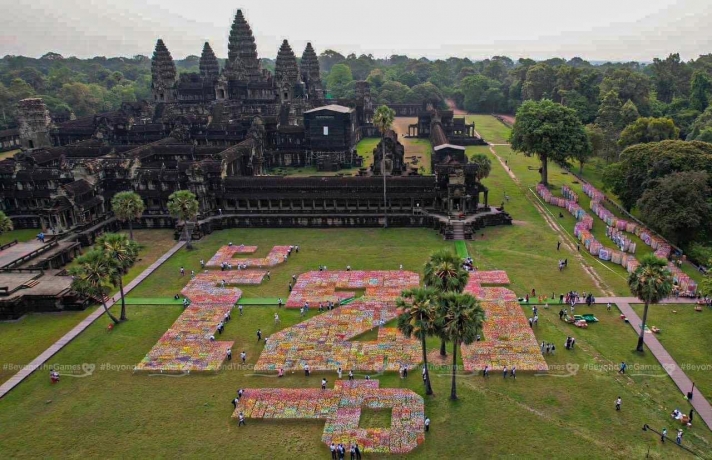
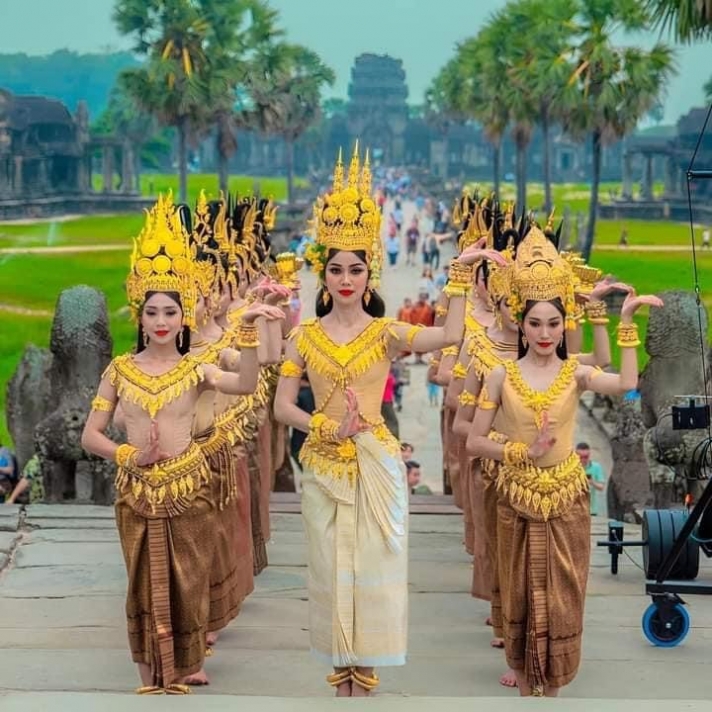
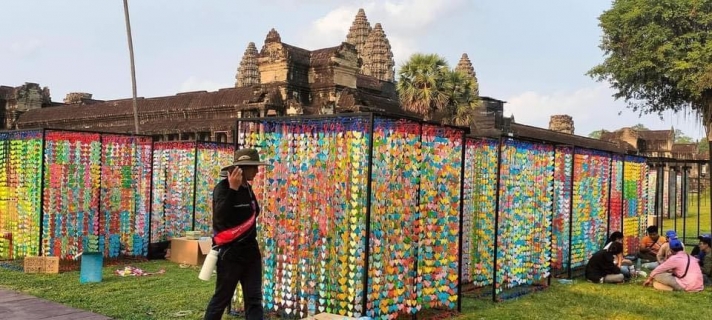
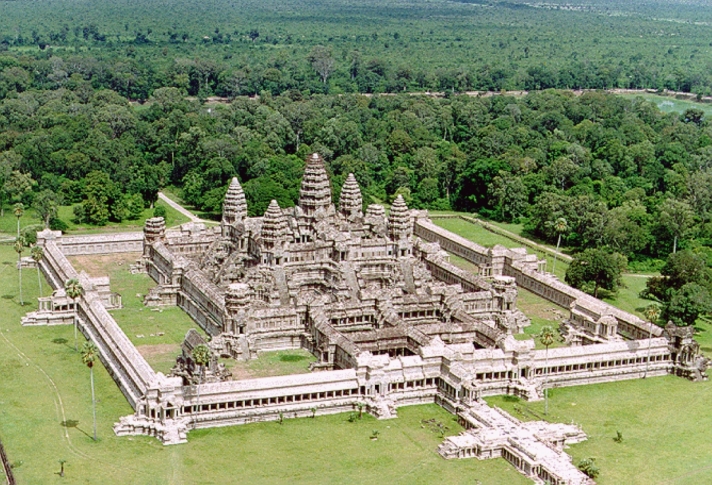
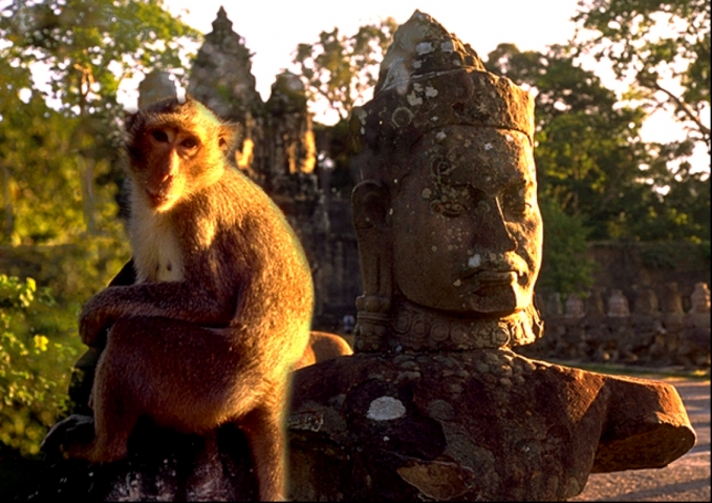
.jpg)
